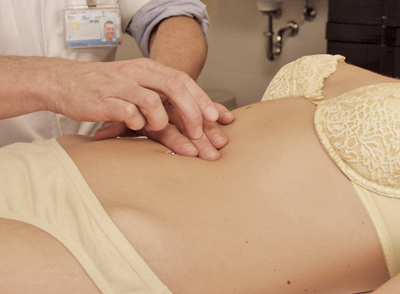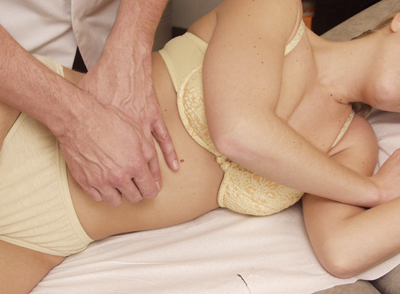Fluid accumulation in the abdominal cavity space is referred to as ascites. Ascites is always a symptom of a serious condition. It can arise through increased fluid production in the peritoneum, which may be caused by carcinomatous peritonitis, or by problems with normal circulatory fluid back-flow, e.g. due to hypoalbuminaemia or portal hypertension.
Inspection
Note the shape of the abdomen, particularly the flanks.
Fluid sinks to the lowest point. If the patient lies on their back, the flanks will bulge out due to the weight of the fluid and the navel will protrude.
Also note other signs of hypoalbuminaemia, such as oedema, or liver abnormalities (see “The examination of the liver and gall bladder”).
Percussion
Suspected ascites in a patient with a swollen abdomen can be confirmed by percussion. Again, fluid sinks to the lowest point and the air-filled intestines will ‘float’ to the top.
Procedure
- Ask the patient to lie on their back.
- Begin percussion at the navel and progress in different directions toward the flanks [Figure 45].
 Figure 45
Figure 45
- Note the transition from tympany (intestines) to dullness (fluid).
This border will run horizontally along the fluid level. - Ask the patient to lie on their side.
- Repeat percussion starting at the elevated side in a downward direction and note the transition from tympany to dullness [Figure 46].
 Figure 46
Figure 46
- If ascites is present, the elevated flank will exhibit tympany while the lower flank will display dullness upon percussion. This is refered to as shifting dullness.
Palpation
If a great deal of free fluid is present (more than 1,5 litres), it is possible to evoke undulation. A quick jab in one flank with one hand will produce a wave effect that can be felt in the opposite flank with the other hand.




























